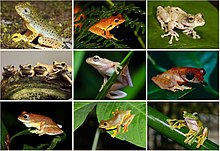Rhacophoridae
| Rhacophoridae | |
|---|---|

| |
| Rhacophoridae diversity | |
| Scientific classification | |
| Domain: | Eukaryota |
| Kingdom: | Animalia |
| Phylum: | Chordata |
| Class: | Amphibia |
| Order: | Anura |
| Clade: | Ranoidea |
| Family: | Rhacophoridae Hoffman, 1932 (1858) |
| Subfamilies | |
The Rhacophoridae are a
Although a few groups are primarily
The species within this family vary in size from 1.5 to 12 cm (0.59 to 4.72 in).
Taxonomy
Evolution
The Rhacophoridae are the sister group to the Mantellidae, a family of frogs restricted to Madagascar. Both families are thought to have diverged during the Paleocene, although previous studies estimated a Cretaceous divergence. Two different hypotheses for this divergence have been proposed: one that the Mantellidae and Rhacophoridae diverged when Insular India broke from Madagascar, with the Rhacophoridae colonizing the rest of Asia following the collision of India with Asia, and the other proposing that the common ancestors of both families inhabited Asia, with the ancestral Mantellidae colonizing Madagascar from India via long-distance dispersal, using India as a stepping stone.[3][4]

Genera
- Subfamily BuergeriinaeChanning, 1989
- Buergeria Tschudi, 1838
- Subfamily Rhacophorinae Hoffman, 1932 (1858)
- Beddomixalus Abraham, Pyron, Ansil, Zachariah, and Zachariah, 2013
- Chirixalus Boulenger, 1893
- Chiromantis Peters, 1854
- Feihyla Frost, Grant, Faivovich, Bain, Haas, Haddad, de Sá, Channing, Wilkinson, Donnellan, Raxworthy, Campbell, Blotto, Moler, Drewes, Nussbaum, Lynch, Green, and Wheeler, 2006
- Ghatixalus Biju, Roelants, and Bossuyt, 2008
- Gracixalus Delorme, Dubois, Grosjean, and Ohler, 2005
- Kurixalus Ye, Fei, and Dubois, 1999
- Leptomantis Peters, 1867
- Liuixalus Li, Che, Bain, Zhao, and Zhang, 2008
- Mercurana Abraham et al., 2013[5]
- Nasutixalus Jiang, Yan, Wang, and Che, 2016
- Nyctixalus Boulenger, 1882
- Philautus Gistel, 1848
- Polypedates Tschudi, 1838
- Pseudophilautus Laurent, 1943
- Raorchestes Biju, Shouche, Dubois, Dutta, and Bossuyt, 2010
- Rhacophorus Kuhl and Van Hasselt, 1822
- Rohanixalus Biju, Garg, Gokulakrishnan, Chandrakasan, Thammachoti, Ren, Gopika, Bisht, Hamidy, and Shouche, 2020
- Taruga Meegaskumbura, Meegaskumbura, Bowatte, Manamendra-Arachchi, Pethiyagoda, Hanken, and Schneider, 2010
- Theloderma Tschudi, 1838
- Vampyrius Dubois, Ohler, and Pyron, 2021
- Zhangixalus Li, Jiang, Ren, and Jiang, 2019
Phylogeny
This phylogeny of the Rhacophoridae is from Yu et al. (2008):[6]
| Rhacophoridae | |
Parasites
As many frogs, rhacophorids harbour
References
- ^ ISBN 0-12-178560-2.
- ^ Sunny Shah & Rachna Tiwari (2001-11-29). "Rhacophorus nigropalmatus, Wallace's Flying Frog". AmphibiaWeb. Retrieved 2007-06-22.
Edited by Tate Tunstall (2003-04-12)
- PMID 23401521.
- PMID 28673970.
- PMID 26000411.
- ^ Yu Guohua, Rao Dingqi, Zhang Mingwang, Yang Junxing. Re-examination of the phylogeny of Rhacophoridae (Anura) based on mitochondrial and nuclear DNA. Molecular Phylogenetics and Evolution 50 (2009) 571–579. doi:10.1016/j.ympev.2008.11.023
- PMID 31746733.

- Cogger, H.G.; R.G. Zweifel; D. Kirschner (2004). Encyclopedia of Reptiles & Amphibians Second Edition. Fog City Press. ISBN 1-877019-69-0.
External links
 Data related to Rhacophoridae at Wikispecies
Data related to Rhacophoridae at Wikispecies Media related to Rhacophoridae at Wikimedia Commons
Media related to Rhacophoridae at Wikimedia Commons
